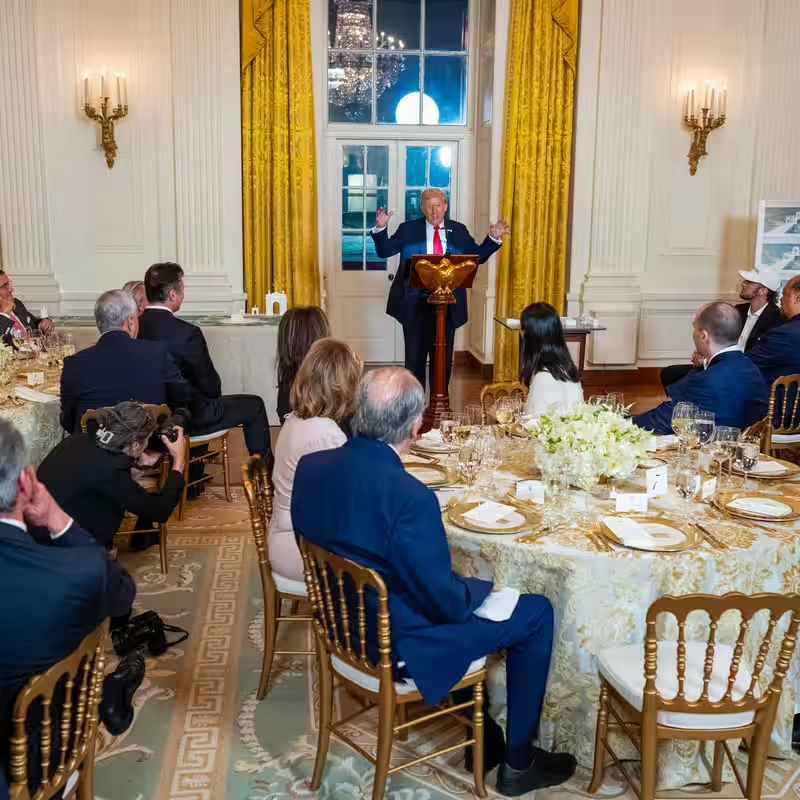Table of Contents
- A Ballroom for Billionaires?
- Who Attended the Dinner?
- Ethical Concerns Mount
- Trump’s Real Estate Logic
- What Happens Next?
- Sources
A Ballroom for Billionaires?
President Trump hosted a high-profile dinner this week inside the White House’s East Room to thank dozens of wealthy donors who have pledged millions toward a controversial $200 million ballroom addition to the presidential residence. The event, held on October 15, 2025, has reignited debates over ethics, influence, and the blending of public office with private fundraising.
“We have a lot of legends in the room tonight,” Trump told attendees, “and that’s why we’re here to celebrate you, because you gave.”
The proposed ballroom—something Trump has long wanted—would be the first major structural expansion to the White House in decades. But unlike past renovations funded through federal appropriations or historical preservation grants, this project is being bankrolled almost entirely by private donations from corporate executives and business elites.
Who Attended the Dinner?
More than three dozen executives from America’s biggest tech and defense firms were present, including representatives from:
- Amazon
- Apple
- Microsoft
- Lockheed Martin
While the White House did not release a full guest list, sources familiar with the event confirmed that many attendees had recently increased lobbying activity in Washington, particularly around defense contracts, AI regulation, and tax policy.
The dinner featured fine china, crystal glassware, and a multi-course menu prepared by the White House executive chef—a stark contrast to the ongoing federal government shutdown that has furloughed thousands of public employees.
Ethical Concerns Mount
Government watchdog groups have raised red flags over the optics—and legality—of hosting a donor dinner at the White House for a privately funded construction project tied directly to the president’s personal vision.
“This blurs the line between public service and private patronage,” said Danielle Brian, executive director of the Project On Government Oversight. “When the president thanks donors inside the very building they’re paying to expand, it creates the appearance of pay-to-play access.”
Legal experts note that while federal law prohibits direct quid pro quo exchanges, it does not explicitly bar presidents from soliciting private funds for White House improvements—especially if the project is framed as benefiting “national prestige” or “diplomatic functions.”
Trump’s Real Estate Logic
True to form, Trump justified the ballroom through the lens of his real estate background. “They wanted to have a ballroom, and it never happened because they didn’t have a real estate person,” he quipped during his remarks.
He argued that previous administrations lacked the “business acumen” to get such a project off the ground. “I know how to build. I know how to make deals. And now, America will finally have a world-class ballroom in its most iconic home.”
Architectural renderings of the proposed addition—though not yet released publicly—are said to include marble floors, gold-leaf accents, and a retractable glass ceiling, drawing comparisons to luxury hotels in Dubai and Mar-a-Lago.
What Happens Next?
The $200 million fundraising goal is reportedly already more than 60% fulfilled, according to a senior White House aide who spoke on background. Construction could begin as early as spring 2026, pending approval from the U.S. Commission of Fine Arts and the National Capital Planning Commission.
However, critics warn the project could become a political liability. “In a time of economic uncertainty and government dysfunction, spending $200 million on a presidential ballroom—funded by billionaires—sends the wrong message,” said Rep. Jamie Raskin (D-MD).
For now, Trump appears undeterred. “This isn’t just a ballroom,” he told guests. “It’s a symbol of American greatness.”




